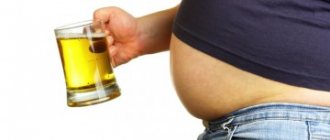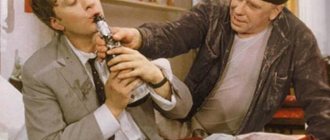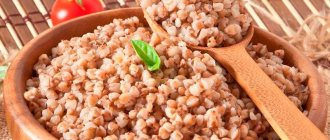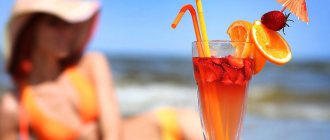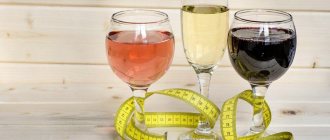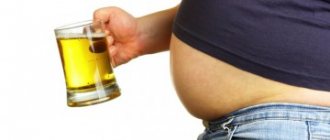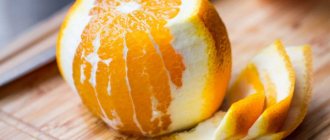The issue of dietary nutrition is inextricably linked with alcoholic beverages, since for most of those who adhere to a certain diet, it is easier to “calculate” the lowest-calorie alcohol than to completely give up the periodic consumption of something intoxicating. What fun drink contains the least amount of calories, and what needs to be done to minimize the harm to your figure during periods of “libations”?
How does alcohol behave when it enters our body?
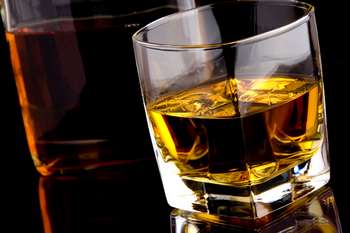
Everything is very simple! When you just take any alcoholic drink into your mouth, it already begins to be absorbed into the blood, and this happens directly in the oral cavity, and then in the stomach. If it enters the body along with any food, then this process slows down a little, so when you snack, you get drunk a little slower.
As a rule, alcohol molecules are broken down both in the stomach and intestines, and the food that came along with them “awaits” its turn. This leads to the fact that fats have time to quickly “hide” in secluded places, because a slow metabolism significantly reduces the rate of fat breakdown.
How then to take this drink? On an empty stomach? In no case - almost all nutritionists say. Alcohol is a powerful appetite stimulant. And this is the most important reason to give up any alcoholic drinks while dieting.
Did you know that alcohol has a diuretic effect? Oh, no need to talk about beer now. Literally all alcoholic drinks, to some extent, dehydrate the body, removing all useful substances with urine.
Studying labels
It is almost impossible to remember the entire calorie table. Carrying it with you in printed form all the time is impractical. Therefore, the best advice is to study the labels. If it is critical for you to know how many calories you consume, then carefully study the labels on alcoholic beverages. Those who have already begun to lean towards switching to non-alcoholic analogues of their favorite drinks should definitely keep in mind that many of these options may turn out to be even higher in calories. For example, non-alcoholic beer has only 10 kcal less than classic beer. Therefore, there is no point in denying yourself pleasure for the sake of a few kilocalories. It is much wiser to comply with the norm, not exceed it and prefer light snacks.
Drink alcohol correctly and it will not harm your figure!
In order for alcohol molecules to cause minimal harm to our health, it is necessary to ensure that they are absorbed very slowly. How?
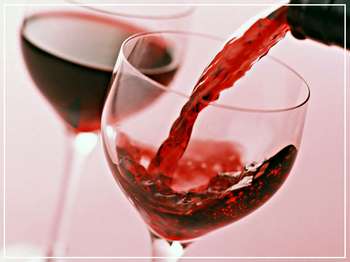
Now you will understand this:
- Never mix it with carbonated drinks, and also limit the amount of champagne or cocktail you drink. As you know, beer contains carbon dioxide, due to which this drink is classified as one that is slowly absorbed.
- As an appetizer, choose something more substantial than all kinds of cuts. A piece of boiled meat is ideal for allowing alcohol molecules to be absorbed more slowly.
- If you prefer alcohol-containing drinks, then choose one that contains less alcohol.
- Cocktails prepared in cafes are a source of excess sugar, and this is all due to the fact that they mix so many different drinks.
- Before drinking any alcoholic beverage, drink several glasses of water. Thanks to this, you will not only not “overdo it” with alcohol, but also refrain from additional portions of salad or meat.
- Drink alcohol in small doses.
- And, of course, choose the least calorie drink!
Rules
- Drink a glass of wine gradually, savoring it.
- Do not exceed consumption limits at one time, even on major holidays. How many? Beer - no more than a liter, cognac or vodka - 120 grams, wine - 300.
- Alcohol significantly increases your appetite, so as a snack, use low-calorie foods with little sugar.
- Eating low-fat meat snacks, fish and plain water slows down the absorption of alcohol into the blood.
- Avoid sweet carbonated alcoholic drinks. They contain the most harmful carbohydrates.
- The fewer degrees, the lower the calorie content. Dilute whiskey with soda, gin with tonic, and wine with water. Add more ice to your drinks.
- Drink alcohol in small portions. This will allow alcohol to enter the bloodstream more slowly.
- A couple of cocktails contain over 600 kcal in the form of harmful carbohydrates.
- Tannins in red wine, whiskey and cognac slow down the absorption of ethyl alcohol, so these types of drinks are the least harmful and most beneficial in small doses.
- Fruits and soda speed up the release of alcohol into the blood.
- Remember that although beer and wine are the lowest calorie alcohols in the table, they are usually drunk in large quantities and add up to a large amount. You don’t need to have a calculator to calculate that by drinking 1 liter of beer with 45 calories (data from the table), you will get 450 kcal.
- Start your meal with a glass of water. This will quench your thirst and reduce your alcohol consumption.
- Remember that the following “light” alcoholic drinks contain more calories:
- liqueurs;
- champagne;
- sweet wines and martinis;
- cocktails;
- port wines.
Due to its energy value, alcohol can greatly increase blood glucose levels. It dissolves fats in cell membranes and increases their permeability. As a result, blood sugar rises sharply. This provokes a feeling of hunger that is difficult to cope with. Most often, a person begins to consume fatty and sweet foods rich in carbohydrates along with alcohol, and as a result, eats much more than usual. Thus, regular consumption of alcohol provokes the process of weight gain.
If the body, excited by alcohol, demands food, but does not receive it on time, then all the calories will then be stored “in reserve” in the form of fat. Therefore, in order for the diet to lead to weight loss, refrain from drinking alcohol in large quantities. The empty calories that alcohol contains in the form of simple carbohydrates put increased stress on the pancreas. Be aware of the risk of alcoholism and take care of your health.
Top 10 low-calorie alcoholic drinks
The table, which shows the lowest calorie drinks, will help you very quickly figure out how many calories are in the product you have chosen.
| Place | Drink name | Calorie content |
| 1 | Light beer | This drink is considered low-calorie, because 100 grams of the product contains 60 kcal. The only problem is that it is consumed in larger quantities than stronger drinks. |
| 2 | Dry wine | It ranks second in calorie content - 70 units. And besides, it contains tannins, which, in turn, slow down the process of absorption of alcohol molecules. |
| 3 | Semi-dry wine | Its calorie content is 78 units. |
| 4 | Dry champagne | It has a calorie content of 85 kcal. By the way, the presence of “bubbles” in a glass of champagne does not have a very good effect on your body |
| 5 | Semi-sweet wine | Here – 90 kcal. |
| 6 | Sweet wine | The calorie content of such a drink is about 100 kcal. |
| 7 | Dark beer | Its calorie content is the same as the previous contender - 100 units. |
| 8 | Semi-sweet champagne | It already contains 120 kcal. |
| 9 | Vodka, cognac, whiskey, brandy | Imagine, 100 grams of these products contain approximately 240 kcal. |
| 10 | Liqueur, liqueur-based cocktails | This is the highest calorie alcoholic drink. If you drink 100 grams, at least 300 kcal will be added to your body. |
That's it! Therefore, at various feasts, choose the “right” alcoholic drinks so as not to add a couple of extra pounds.
Root of Evil
Oddly enough, girls are especially at risk. They are the ones who usually choose sweet alcoholic drinks. Men are rarely interested in such cocktails, preferring if they dilute alcohol, then only with ice. Therefore, the first misconception is to look for the lowest calorie alcohol among the lightest drinks. How are cocktails made? Often this is strong alcohol (vodka, cognac, rum), which is the highest in calories, mixed with sweet juices and soda. Sometimes condensed milk, various syrups, chocolate, eggs, ice cream are added to this, which only increases the load on your liver and the risk of a sharp increase in body weight.
Beer has pitfalls
As a rule, all types of beer include monosodium glutamate, which today is very zealously discussed by all those who promote a healthy lifestyle.
This famous supplement is today credited with causing a huge number of all kinds of diseases, some of them quite serious. Therefore, if you still decide to have a glass of beer with friends, then do not buy store-bought snacks. The best option for a beer snack is fish prepared at home. You can try dietary meat, which will only slow down the process of absorption of alcohol molecules. It is important to remember that beer that contains a large amount of alcohol will also add more calories to your body.
In addition to all of the above, I would like to note that people do not drink one hundred grams of beer per evening. At least 500 ml, which is already from 250 to 400 kcal. The carbon dioxide present, according to research, has a very detrimental effect on the functioning of the liver and cardiovascular system.
Therefore, do not be too fooled by the fact that beer is the lowest-calorie alcoholic drink. And if you really want to drink something with a strong degree, then a glass of dry wine is what you need.
The lightest cocktails
If you still haven’t been able to choose what you will drink at your next feast, then let’s count the calorie content of alcohol together. The lowest calorie is definitely diluted alcohol. Therefore, we decided to give you several recipes that are often served in restaurants.
- Mimosa cocktail - 100 ml of sparkling champagne and 100 ml of freshly squeezed orange juice. Calorie content – 120 ml.
- The Spritzer is a great option for those who don't want to gain weight or get drunk. Take one part white table wine and ½ mineral water. Calorie content of 100 ml of wine is 120 kcal.
- “Bellini” - this glamorous cocktail was invented by the Italians. Surprising and bright, it is perfect for a friendly party. Mix 100 ml sparkling wine (85 kcal) and 50 ml fresh peach puree (45 kcal). The result is 130 kcal.
- Bloody Mary is a favorite combination of tomato juice and vodka. In fact, a very good option if you limit yourself to one cocktail. Take 45 ml of vodka (135 kcal), 90 ml of tomato juice (16 kcal), add lemon juice, a little salt and pepper. The output is 154 kcal.
And again I would like to repeat that all these recipes work well only if you do not order one cocktail after another. True, in this case, their price comes to protect the figure. Buying a dozen cocktails at a bar is often too expensive, but the same cannot be said for a couple of beers at a bar.“>
Briefly about the main thing
So, to summarize, I would like to note the following:
- Medical research shows that light beer is the lowest-calorie alcoholic drink. However, you should not lean on it. Firstly, its calorie content is low in relation to 100 grams of product, and the amount of beer consumed, as a rule, reaches at least 0.5 liters. Secondly, it contains harmful additives that can cause some serious diseases.
- Don’t forget to have a good meal after drinking a glass, and preferably not with fast food, but with healthy and proper food. This will slow down the absorption of alcohol molecules into the blood.
- Remember, even if you drink a low-calorie alcoholic drink, it will still stimulate your appetite.
- In general, if you have the opportunity, then give up alcohol completely. This way you will help your body receive only vitamins and beneficial microelements from the food and drink you eat.
We wish you good health!
Even more numbers
To make it easier to understand, we present to your attention a summary table of the most popular drinks and their calorie content.
| Type of drink (100 grams) | Carbohydrates | Kcal |
| Beer | ||
| Light (11% wort) | 4.6 | 43 |
| Light (20% wort) | 7.6 | 74 |
| Dark (wort 13%) | 5.7 | 47 |
| Dark (20% wort) | 8.7 | 73 |
| Wine | ||
| Dry | 0.3 | 63 |
| Semi-dry (white and red) | 2.5 | 77 |
| Semi-sweet (white and red) | 5 | 87 |
| Sweet (white and red) | 8 | 100 |
| Semi-dessert | 12 | 138-140 |
| Dessert | 20 | 170 |
| Strong | 12 | 162 |
| Strong alcohol | ||
| Liquor | 40 | 290-300 |
| Tincture | 6.4 | 246 |
| Cognac | 1.5 | 239 |
| Vodka | 0.4 | 235 |
| Brandy | 0.5 | 225 |
| Rum | 220 | |
| Tequila | 24 | 231 |

What kind of wine can you drink while on a diet?
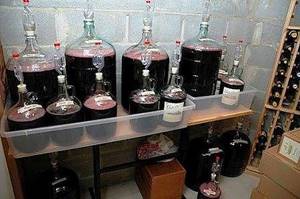
In order not to receive a low-quality product from the store, you can prepare dry red wine at home. To do this, you need to follow several steps:
- Preparation of the must: place a colander over an enamel container, place the grapes in it and mash it with your hands.
- Preparing for fermentation - fill the container into three parts with wort and cover with gauze, then the can or pan is removed for several days in a room with a temperature of 30 degrees.
- The wort needs to be stirred several times a day.
- Next, the juice without sediment should be poured into a bottle 2/3 full (with a narrow neck).
- At the fermentation stage, you need to secure a special lid to the neck of the container with juice; you can use a glove with a small hole in one of the fingers.
- Afterwards, remove the composition for 25 days in a room with a temperature of up to 20 degrees.
- When a complete absence of bubbles begins to be observed, this will mean that the fermentation process has completed.
- At the ripening stage, the liquid without sediment is poured into another container and tightly closed with a lid.
Dry wine for diet is completely ready.
Diet with alcohol instead of food
This is a diet in which one meal is replaced with an alcoholic drink. It could be lunch or dinner - it's up to you. It is hardly convenient to drink alcohol during your lunch break during working hours. Therefore, you can only afford alcohol at lunch on weekends.
A diet that allows you to drink alcohol is as follows:
- Avoid sugar and salt completely.
- You should only drink water and wine.
- The diet should be varied. For example, for breakfast, eat a boiled egg with cucumber. For second breakfast - an orange or an apple. For lunch, low-fat cottage cheese with fruit is suitable. In the evening, drink a glass of dry red wine.
- Don't forget to drink more water.
- You can lose up to 3-5 kg by following this diet. In five days you will notice the result.
- What kind of alcohol can you drink while dieting? The best option is dry red wine.
This diet is more restrictive in food intake. This means the supply of useful substances. It should not be extended for more than 5 days. The body must receive all nutrients, proteins, fats and carbohydrates. Nutrition should be complete.
It is better to consult a doctor before deciding on such experiments.

Alcohol for weight loss
In general, drinking alcohol while dieting is not recommended. Our body urgently needs carbohydrates, protein and fat compounds, which are needed as plastic, construction and other materials. Calories from alcohol do not provide these energy elements. An exception is wine during diets; it improves digestion, metabolism and general organic activity.
After drinking alcohol, the body spends enormous efforts on processing it, after which the person again experiences a strong feeling of hunger, a terrible appetite develops and the patient breaks off the diet.
